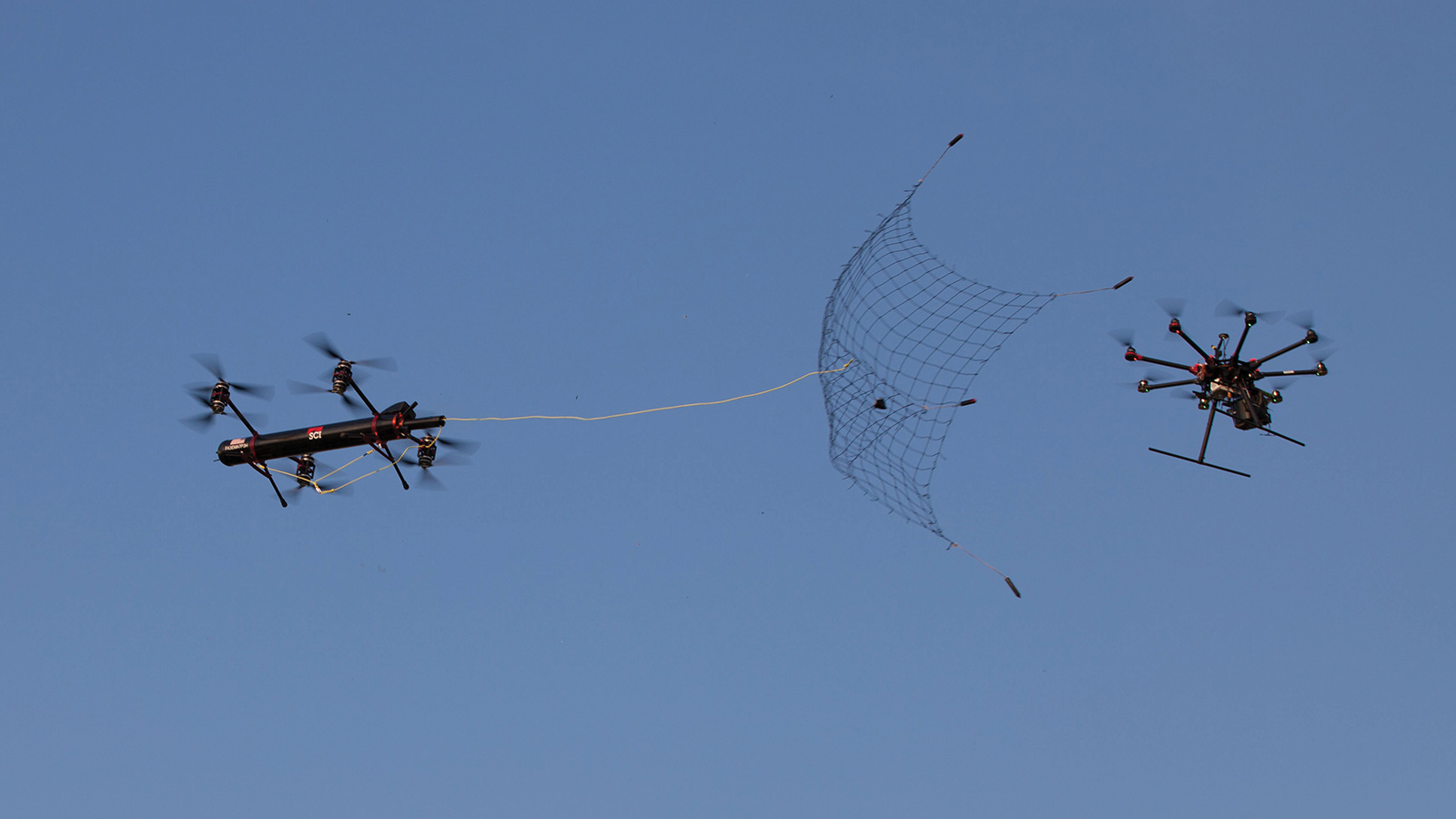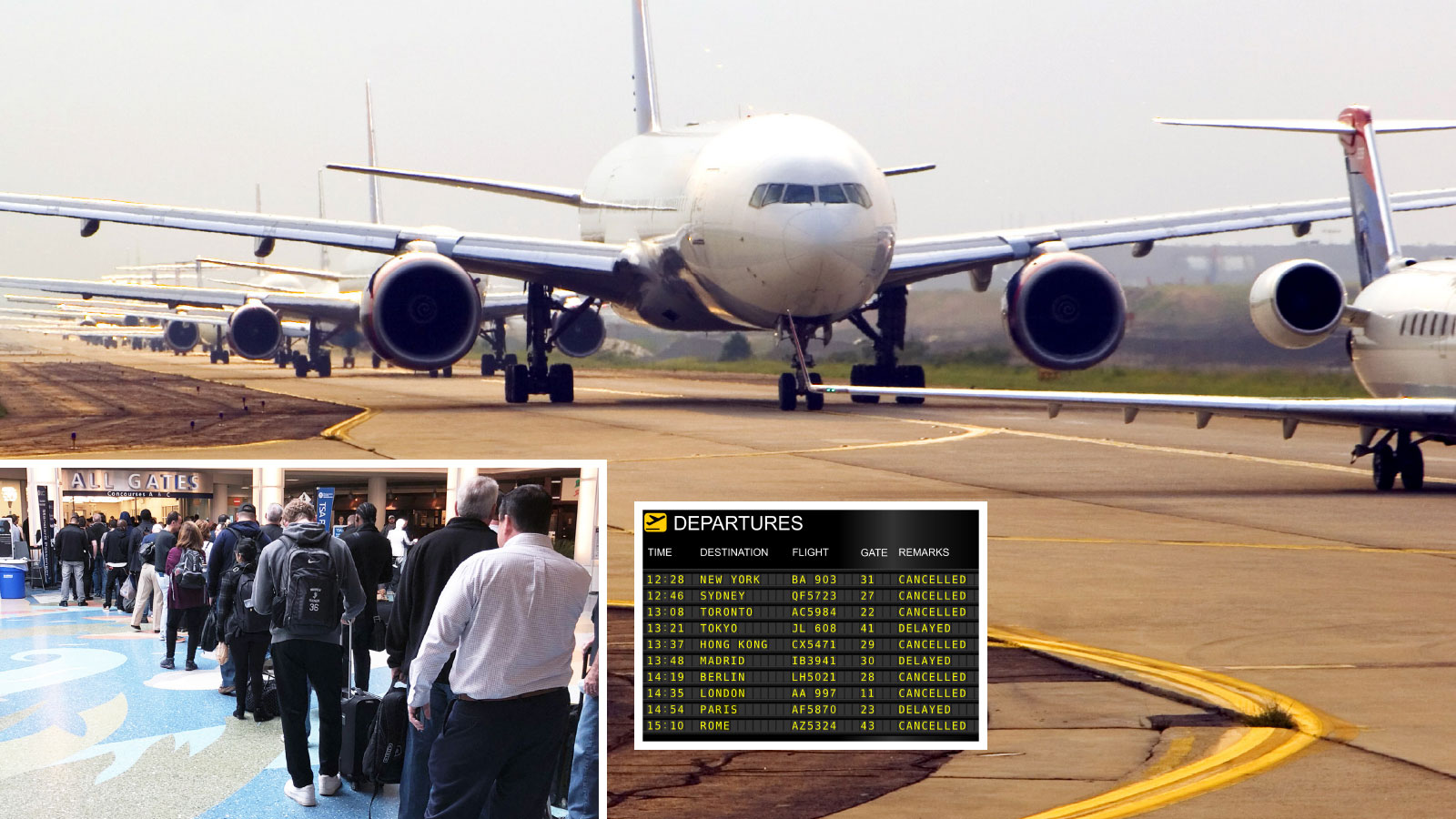Stay Up to Date
Submit your email address to receive the latest industry and Aerospace America news.
Airport authorities know that they can’t let wayward consumer drones paralyze airports. Companies in the U.S. and abroad have demonstrated a range of technologies for detecting and neutralizing drones, but a consensus has yet to emerge on the best solutions, writes Marc Selinger.
A consumer drone under a Christmas tree is good. The same drone flying near an airport frequented by holiday travelers is bad. The point was proved at London’s Gatwick Airport last December, when a series of drone spottings disrupted 1,000 flights and delayed 140,000 travelers, according to The Times of London. A month later, flights out of New Jersey’s Newark Liberty International Airport were briefly halted when two pilots reported seeing a drone flying at 3,500 feet, according to The New York Times.
Did it take a flock of drones, sometimes called unmanned aircraft systems, to paralyze air travel? No, just one or two perhaps flown over and over again, based on witness accounts in news reports.
In the U.S. and abroad, the incidents at Gatwick and Newark have heightened efforts to try out and select technologies that can detect, track and stop drones that accidentally or intentionally fly too close to civilian or military sites.
Even before the headline-grabbing cases at Gatwick and Newark, academics who study these matters were sounding the alarm and urging faster action. Arthur Holland Michel, co-director of Bard College’s Center for the Study of the Drone in upstate New York, wrote in a report last year that “near misses between drones and manned aircraft have become a common occurrence in every crowded airspace system in the world, and many worry that a collision between a manned aircraft and an unmanned aircraft could result in a catastrophic accident.” The United Kingdom incident underscored the impacts of disruptions short of calamity.
“It cannot be right that drones can close a vital part of our national infrastructure in this way,” Gatwick CEO Stewart Wingate said in a statement at the time. The intrusions highlighted “a wider strategic challenge for aviation” in the U.K., “which we need to address together with speed — the aviation industry, government and all the other relevant authorities.”
“New hot topic”
In the U.S., 160 companies have devised 300 products, with participants representing “a good mixture” of startups and well-established firms, says Tim Bennett, who oversees counterdrone efforts at the U.S. Department of Homeland Security’s Science and Technology Directorate.
“It’s the new hot topic that everybody wants to get involved with,” says Bennett.
Through a pilot program, the FAA tested a variety of drone detection systems at four airports from February 2016 to December 2017. Spurred by a provision in the 2018 FAA Reauthorization Act, the FAA is formulating plans “to conduct additional pilot program activity related to evaluation of detection and mitigation systems at airports,” the agency said in a statement.
In addition, the Utah Department of Transportation’s Division of Aeronautics has given Fortem Technologies permission to evaluate drone-detecting radar at two runways at Salt Lake City International Airport. The department has access to the data that Fortem collects and might eventually buy the company’s radar for its own use, a spokesman says.
Despite the various counterdrone efforts by government and industry, experts say no consensus has emerged on the best way to address the problem.
Michel of Bard College says that all detection systems have drawbacks. Radar can struggle to see small, low-flying drones. Electro-optical and infrared systems must have direct line of sight with a drone. Systems that detect a drone’s sound or radio links rely on libraries that must be updated regularly.
“There’s no one good system that will do it,” Bennett says. “It’s going to have to be a collection of different sensors and systems to go together to make it operate.”
Stopping a drone is considered an even bigger problem than detecting and tracking it. The U.S. military can often shoot drones out of the sky when it encounters them on barren battlefields overseas. But that is more problematic at, say, civilian airports because flaming debris could fall on and injure people.
Another way to down drones would be to jam their communications links or GPS signals. But those tools will become less effective as drones increasingly fly autonomously, with no communications links, and become more reliant on other forms of navigation, such as mapping software.
Within a few years, drones will be “all-silent aircraft” that require “other means” to stop them, Bennett explains.
Fighting drones with drones
Some of the newer interdiction systems would capture drones with nets, drawing comparisons to the spiderwebs that Spider-Man fires from his wrist to trap villains.
Denver-based Liteye Systems, for example, offers two ground-launched net guns: the hand-held SkyWall 100 and the larger, longer-range SkyWall 300, which can be mounted on a turret. Both systems fire a projectile that releases a net to entangle the drone. A parachute gently lands the intruder.
Several firms also offer drone-mounted net capture systems.
Utah-based Fortem Technologies, which counts Boeing among its financial backers, has developed DroneHunter. Fortem says that once it installs DroneHunter on a host drone, the aircraft can autonomously patrol an airspace with a radar that can detect and track a drone. It fires a tethered net to capture the intruder drone and tow it to a safe spot on the ground.
SCI Technology of Huntsville, Alabama, has AeroGuard, an octocopter that is launched when a hostile drone is detected. Like DroneHunter, AeroGuard fires a tethered net at a drone and tows the captured device to a safe landing zone.
“This disposal location is typically away from the protected area to prevent exposure to a potentially dangerous payload,” such as a bomb, said Max Klein, SCI’s chief technology officer.
Switzerland’s Skysec is developing Sentinel Catch, a four-winged drone, and Sentinel Catch & Carry, a fixed-wing/quadcopter hybrid. Each interceptor, or “effector,” has a seeker in its nose to help it zero in on a target. After snagging a drone with a towed net, Sentinel Catch deploys a parachute to bring itself and the intruding drone to the ground, while Sentinel Catch & Carry carries the target to a landing zone.
Bennett says he prefers drone-mounted nets over ground-launched ones, which require the shooter to be close to the target.
“I like the idea of using other UAS with the systems on them that can actually net the aircraft and then tow it away somewhere else,” Bennett says. “I think that’s going to be a very promising one.”
But Michel cautioned that drone-mounted nets need to undergo more rigorous testing to prove they perform as advertised.
“It’s such a new technology; we don’t have a lot of data from real-world use,” Michel says. “It’s hard to say at this point to what extent it would or would not work or whether there are unexpected variables that could influence how well it works or how safe it is.”
Kenneth Geyer, Liteye’s CEO and co-founder, offers a similar assessment.
“Liteye will continue to evaluate all the different technologies out there, including UAS-mounted net solutions,” Geyer says. “Only when we have seen a technology tested under live fire, unscripted testing will we consider recommending its deployment.”
“There’s no one good system that will do it. It’s going to have to be a collection of different sensors and systems to go together to make it operate.”
Tim Bennett, U.S. Department of Homeland Security
About Mark Selinger
A former congressional reporter and Pentagon correspondent, Marc has written for more than 20 aerospace and defense publications.
Related Posts
Stay Up to Date
Submit your email address to receive the latest industry and Aerospace America news.






